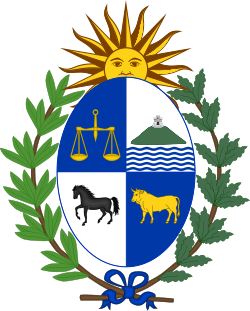2019 Uruguayan constitutional referendum
A constitutional referendum was held in Uruguay on 27 October 2019, alongside general elections. The proposed amendments to the constitution would create a national guard, forbid early release for some serious crimes, introduce life sentences for crimes of rape or sexual abuse or homicide of minors as well as aggravated homicide of adults, and allow the police to conduct night raids.[1] The proposals were rejected by 53% of voters.
 |
|---|
| This article is part of a series on the politics and government of Uruguay |
|
Executive
|
|
Legislative
|
|
Administrative divisions |
|
|
|
|
See also |
|
|
Campaign
No presidential candidate supported the proposal, which was backed by Senator Jorge Larrañaga. However, several opposition candidates proposed similar measures regarding public safety.[2]
Results
Voters participating in the general elections had the opportunity to take a ballot in favour of the proposed amendment, and attach it to their ballots in their envelopes, or not to do so. Only the presence (or not) of the "yes" ballot was recorded as a vote being cast, with no invalid votes possible.
Although legally binding, in order to be considered valid, the proposal must receive an absolute majority of votes in its favour, and be supported by at least 35% of registered voters (turnout). The measure failed, receiving the necessary quorum but not a majority of votes in favour. The total number of registered voters used to calculate the referendum turnout rate differed slightly from that of registered voters for the elections held on the same day, as some foreign nationals with a significant period of residency were able to vote in elections, but not in referendums.
| Choice | Votes | % |
|---|---|---|
| For | 1,139,433 | 46.83 |
| Not support | 1,293,931 | 53.17 |
| Total | 2,433,364 | 100 |
| Registered voters/turnout | 2,699,463 | 90.14 |
| Source: Corte Electoral | ||
References
- ¿Qué implica la reforma constitucional de Larrañaga? El Observador, 25 February 2019
- "Todos con la gorra". Brecha (in Spanish). 23 August 2019.